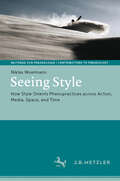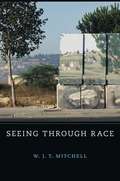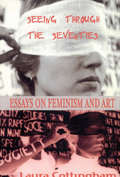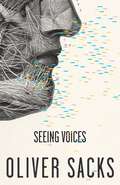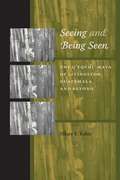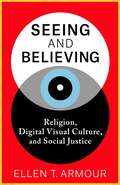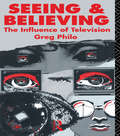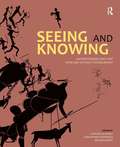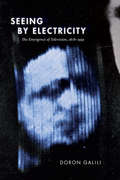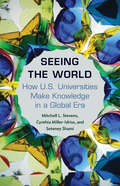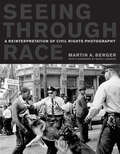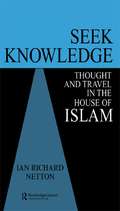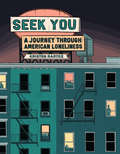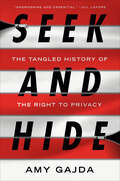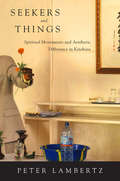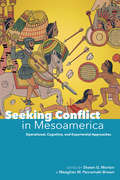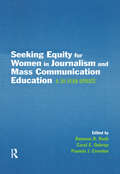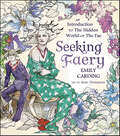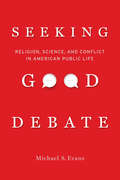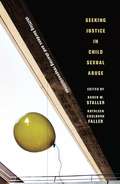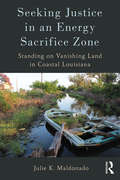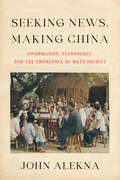- Table View
- List View
Seeing Style: How Style Orients Phenopractices across Action, Media, Space, and Time (Beiträge zur Praxeologie / Contributions to Praxeology)
by Niklas WoermannHow do social practices prefigure experiences, and how does embodied experience organize the performance of practices? This book suggests that the classic concept of style offers a fresh answer to the question how doings and sayings are linked into practice bundles. Based on a rich ethnographic study of the visual practices of the German-speaking freeskiing subculture, this work develops a theory of phenopractices, or embodied cultural practices dedicated to apprehending and expressing style. Focusing on the visual dimension, it extends the thought of Garfinkel and Schatzki using recent insights from science and technology studies and research at the intersection of neuroscience and phenomenology. This offers a new perspective on fundamental practice-theoretical questions about the nature of practice elements, social order in the context of rules and regularity, or action and practical intelligibility. Each chapter discusses and develops foundational concepts such as time, space, action, emotion, or perception based on an analysis of freeskiing practices such as planning a route in the backcountry, testing a new ski model, or judging freestyle contests. The central argument is that cultural styles of conduct are not only symbolic structures, but a functional resource which organizes situational intelligibility and thus enables social order based on aligned and managed embodied routines. Because the stabilization, dissemination, and evolution of such styles happens via different media, practice change is primarily influenced by media rather than symbolic, rational, or functional needs or ends. A rich ethnography and provocative theoretical argument of interest to anyone working on contemporary practice thought, advancing phenomenology, the sociology of vision, lifestyle sports, media, or practice evolution.
Seeing Through Race
by Mitchell W. J. T.According to W. J. T. Mitchell, a color-blind post-racial world is neither achievable nor desirable. Against popular claims that race is an outmoded construct that distracts from more important issues, Mitchell contends that race remains essential to our understanding of social reality. Race is not simply something to be seen but is among the fundamental media through which we experience human otherness. Race also makes racism visible and is thus our best weapon against it. The power of race becomes most apparent at times when pedagogy fails, the lesson is unclear, and everyone has something to learn. Mitchell identifies three such moments in America’s recent racial history. First is the post–Civil Rights moment of theory, in which race and racism have been subject to renewed philosophical inquiry. Second is the moment of blackness, epitomized by the election of Barack Obama and accompanying images of blackness in politics and popular culture. Third is the Semitic Moment in Israel-Palestine, where race and racism converge in new forms of anti-Semitism and Islamophobia. Mitchell brings visual culture, iconology, and media studies to bear on his discussion of these critical turning points in our understanding of the relation between race and racism.
Seeing Through Race (The\w. E. B. Du Bois Lectures #11)
by W. J. MitchellAccording to Mitchell, a “color-blind” post-racial world is neither achievable nor desirable. Against claims that race is an outmoded construct, he contends that race is not simply something to be seen but is a fundamental medium through which we experience human otherness. Race also makes racism visible and is thus our best weapon against it.
Seeing Through the Seventies: Essays on Feminism and Art (Critical Voices In Art, Theory, Culture Ser.)
by Laura CottinghamIn recent years, Laura Cottingham has emerged as one of the most visible feminist critics of the so-called post-feminist generation. Following a social-political approach to art history and criticism that accepts visual culture as part of a larger social reality, Cottingham's writings investigate central tensions currently operative in the production, distribution and evaluation of art, especially those related to cultural production by and about women.Seeing Through the Seventies: Essays on Feminism and Art gathers together Cottingham's key essays from the 1990's. These include an appraisal of Lucy R. Lippard, the most influential feminist art critic of the1970's; a critique of the masculinist bias implicit to modernism and explicitly recuperated by commercially successful artists during the 1980s; an exhaustive analysis of the curatorial failures operative in the "Bad Girls" museum exhibitions of the early 1990s; surveys of feminist-influenced art practices during the women's liberationist period; speculations on the current possibilities and obstacles that attend efforts to recover lesbian cultural history; and an examination of the life, work and obscuration of the early twentieth-century French photographer Claude Cahun.
Seeing Voices: A Journey into the World of the Deaf
by Oliver SacksSign language is, in the hands of its masters, a most beautiful and expressive language.
Seeing and Being Seen: The Q'eqchi' Maya of Livingston, Guatemala, and Beyond
by Hilary E. KahnThe practice of morality and the formation of identity among an indigenous Latin American culture are framed in a pioneering ethnography of sight that attempts to reverse the trend of anthropological fieldwork and theory overshadowing one another.<P><P>In this vital and richly detailed work, methodology and theory are treated as complementary partners as the author explores the dynamic Mayan customs of the Q'eqchi' people living in the cultural crossroads of Livingston, Guatemala. Here, Q'eqchi', Ladino, and Garifuna (Caribbean-coast Afro-Indians) societies interact among themselves and with others ranging from government officials to capitalists to contemporary tourists.
Seeing and Believing: Religion, Digital Visual Culture, and Social Justice
by Ellen T. ArmourSocial media platforms are often denounced as “bubbles” or “echo chambers.” In this view, what we see tends to reinforce what we already believe, and what we already believe shapes what we see. Yet social movements such as Black Lives Matter rely heavily on the widespread dissemination of digital photographs and videos through social media. In at least some cases, visual images can challenge normative and normalized ways of grasping the world and prompt their viewers to see differently—and even bring people together.Seeing and Believing marshals religious resources to recast the significance of digital images in the struggle for social justice. Ellen T. Armour examines what distinguishes digital photography from its analogue predecessor and places the circulation of digital images in the broader context of virtual visual cultures. She explores the challenges and opportunities that visually saturated social media landscapes present for users and organizers. Despite the power of digital platforms and algorithms, possibilities for disruption and resistance emerge from how people engage with these systems. Armour offers ways of seeing drawn from Christianity and found in other religious traditions to help us break with entrenched habits and rethink how we engage with the images that grab our attention. Developing theological perspectives on the power and peril of photography and technology, Seeing and Believing provides suggestions for navigating the new media landscape that can spark what Armour calls “photographic insurrection.”
Seeing and Believing: The Influence of Television (Communication and Society)
by Greg PhiloTelevision has a powerful impact on our beliefs and is open to use as a political and propaganda tool. Greg Philo has taken a new approach to examining these issues by inviting groups of television viewers to write their own news programmes, based on news pictures from the 1984-5 British miners' strike.
Seeing and Consciousness: Women, Class and Representation
by Gen DoyThrough its provocative examination of feminist and Marxist approaches to women's art and female representations, this book challenges the widespread belief that Marxism has nothing valuable to contribute to women's studies. The author argues that, from the French Revolution through to the present, gender and class have shaped visual imagery. She shows how Marxist theory can function to question some of the premises of feminist art histories and to provide a more accurate understanding of the meaning(s) of visual imagery.
Seeing and Knowing: Understanding Rock Art with and without Ethnography
by Geoffrey Blundnell Christopher Chippindale Benjamin SmithThe purpose of Seeing and Knowing is to demonstrate the depth and wide geographical impact of David Lewis-Williams’ contribution to rock art research by emphasizing theory and methodology drawn from ethnography. Contributors explore what it means to understand and learn from rock art, and a contrast is drawn between those sites where it is possible to provide a modern, ethnographic context, and those sites where it is not. This is the definitive guide to the interplay between ethnography and rock art interpretation, and is an ideal resource for students and researchers alike.
Seeing by Electricity: The Emergence of Television, 1878-1939 (Sign, Storage, Transmission)
by Doron GaliliAlready in the late nineteenth century, electricians, physicists, and telegraph technicians dreamed of inventing televisual communication apparatuses that would “see” by electricity as a means of extending human perception. In Seeing by Electricity Doron Galili traces the early history of television, from fantastical image transmission devices initially imagined in the 1870s such as the Telectroscope, the Phantoscope, and the Distant Seer to the emergence of broadcast television in the 1930s. Galili examines how televisual technologies were understood in relation to film at different cultural moments—whether as a perfection of cinema, a threat to the Hollywood industry, or an alternative medium for avant-garde experimentation. Highlighting points of overlap and divergence in the histories of television and cinema, Galili demonstrates that the intermedial relationship between the two media did not start with their economic and institutional rivalry of the late 1940s but rather goes back to their very origins. In so doing, he brings film studies and television studies together in ways that advance contemporary debates in media theory.
Seeing the World: How US Universities Make Knowledge in a Global Era
by Mitchell L. Stevens Cynthia Miller-Idriss Seteney ShamiAn in-depth look at why American universities continue to favor U.S.-focused social science research despite efforts to make scholarship more cosmopolitanU.S. research universities have long endeavored to be cosmopolitan places, yet the disciplines of economics, political science, and sociology have remained stubbornly parochial. Despite decades of government and philanthropic investment in international scholarship, the most prestigious academic departments still favor research and expertise on the United States. Why? Seeing the World answers this question by examining university research centers that focus on the Middle East and related regional area studies.Drawing on candid interviews with scores of top scholars and university leaders to understand how international inquiry is perceived and valued inside the academy, Seeing the World explains how intense competition for tenure-line appointments encourages faculty to pursue “American” projects that are most likely to garner professional advancement. At the same time, constrained by tight budgets at home, university leaders eagerly court patrons and clients worldwide but have a hard time getting departmental faculty to join the program. Together these dynamics shape how scholarship about the rest of the world evolves.At once a work-and-occupations study of scholarly disciplines, an essay on the formal organization of knowledge, and an inquiry into the fate of area studies, Seeing the World is a must-read for anyone who cares about the future of knowledge in a global era.
Seeing through Race: A Reinterpretation of Civil Rights Photography
by Martin A. BergerSeeing through Race is a boldly original reinterpretation of the iconic photographs of the black civil rights struggle. Martin A. Berger’s provocative and groundbreaking study shows how the very pictures credited with arousing white sympathy, and thereby paving the way for civil rights legislation, actually limited the scope of racial reform in the 1960s. Berger analyzes many of these famous images—dogs and fire hoses turned against peaceful black marchers in Birmingham, tear gas and clubs wielded against voting-rights marchers in Selma—and argues that because white sympathy was dependent on photographs of powerless blacks, these unforgettable pictures undermined efforts to enact—or even imagine—reforms that threatened to upend the racial balance of power.
Seek Knowledge: Thought and Travel in the House of Islam
by Ian Richard NettonExplores various facets of the Islamic search for knowledge, with essays on aspects of Thought or Travel.
Seek You: A Journey Through American Loneliness (Pantheon Graphic Library)
by Kristen RadtkeFrom the acclaimed author of Imagine Wanting Only This—a timely and moving meditation on isolation and longing, both as individuals and as a societyThere is a silent epidemic in America: loneliness. Shameful to talk about and often misunderstood, loneliness is everywhere, from the most major of metropolises to the smallest of towns. In Seek You, Kristen Radtke's wide-ranging exploration of our inner lives and public selves, Radtke digs into the ways in which we attempt to feel closer to one another, and the distance that remains. Through the lenses of gender and violence, technology and art, Radtke ushers us through a history of loneliness and longing, and shares what feels impossible to share. Ranging from the invention of the laugh-track to the rise of Instagram, the bootstrap-pulling cowboy to the brutal experiments of Harry Harlow, Radtke investigates why we engage with each other, and what we risk when we turn away. With her distinctive, emotionally-charged drawings and deeply empathetic prose, Kristen Radtke masterfully shines a light on some of our most vulnerable and sublime moments, and asks how we might keep the spaces between us from splitting entirely. <P><P><i>Advisory: Bookshare has learned that this book offers only partial accessibility. We have kept it in the collection because it is useful for some of our members. Benetech is actively working on projects to improve accessibility issues such as these.</i>
Seek and Hide: The Tangled History of the Right to Privacy
by Amy Gajda&“This brilliant and thought-provoking book shows how America&’s well-known emphasis on freedom of the press has long been balanced by a deep legal tradition that protects an individual&’s right to privacy. Amy Gajda shows how battles over the right to privacy are nothing new, but they are particularly relevant in this era of digital media and social networks.&”—Walter Isaacson, author of Steve JobsAn urgent book for today's privacy wars: the surprising history of the fitful development of the right to privacy—and its battle against the public&’s right to know.The battle between an individual&’s right to privacy and the public&’s right to know has been fought for centuries. The founders demanded privacy for all the wrong press-quashing reasons. Supreme Court justice Louis Brandeis famously promoted First Amendment freedoms but argued strongly for privacy too; and presidents from Thomas Jefferson through Donald Trump confidently hid behind privacy despite intense public interest in their lives. Today privacy seems simultaneously under siege and surging. And that&’s doubly dangerous, as legal expert Amy Gajda argues. Too little privacy can mean extraordinary profits and power for people who deal in and publish soul-crushing secrets. Too much means the famous and infamous can cloak themselves in secrecy. Seek and Hide carries us from the very start, when privacy concepts first entered American law and society, to now, when the law allows a Silicon Valley titan to destroy a media site like Gawker out of spite. Muckraker Upton Sinclair, like Nellie Bly before him, pushed the envelope of privacy and propriety and then became a privacy advocate when journalists used the same techniques against him. By the early 2000s we were on our way to today&’s full-blown crisis in the digital age, worrying that smartphones, webcams, basement publishers, and the forever internet had erased the right to privacy completely. Should everyone have privacy in their personal lives? Can privacy exist in a public place? Is there a right to be forgotten even in the United States? Is it too late to get control of data privacy? This fascinating and necessary book shows us how the answers may not be what you expect, or hope, how technology makes these issues more complicated than ever before, and how we can learn from the mistakes of the past as we try to balance privacy and First Amendment freedoms in a modern age.
Seeker of Knowledge: The Man Who Deciphered Egyptian Hieroglyphs
by James RumfordA biography of the French scholar whose decipherment of the Egyptian hieroglyphic language made the study of ancient Egypt possible.
Seekers and Things: Spiritual Movements and Aesthetic Difference in Kinshasa
by Peter LambertzFocusing on the intricate presence of a Japanese new religion (Sekai Kyûseikyô) in the densely populated and primarily Christian environment of Kinshasa (DR Congo), this ethnographic study offers a practitioner-orientated perspective to create a localized picture of religious globalization. Guided by an aesthetic approach to religion, the study moves beyond a focus limited to text and offers insights into the role of religious objects, spiritual technologies and aesthetic repertoires in the production and politics of difference. The boundaries between non-Christian religious minorities and the largely Christian public sphere involve fears and suspicion of "magic" and "occult sciences".
Seeking Conflict in Mesoamerica: Operational, Cognitive, and Experiential Approaches
by Shawn G. Morton Meaghan M. Peuramaki-BrownSeeking Conflict in Mesoamerica focuses on the conflicts of the ancient Maya, providing a holistic history of Maya hostilities and comparing them with those of neighboring Mesoamerican villages and towns. Contributors to the volume explore the varied stories of past Maya conflicts through artifacts, architecture, texts, and images left to posterity. Many studies have focused on the degree to which the prevalence, nature, and conduct of conflict has varied across time and space. This volume focuses not only on such operational considerations but on cognitive and experiential issues, analyzing how the Maya understood and explained conflict, what they recognized as conflict, how conflict was experienced by various groups, and the circumstances surrounding conflict. By offering an emic (internal and subjective) understanding alongside the more commonly researched etic (external and objective) perspective, contributors clarify insufficiencies and address lapses in data and analysis. They explore how the Maya defined themselves within the realm of warfare and examine the root causes and effects of intergroup conflict. Using case studies from a wide range of time periods, Seeking Conflict in Mesoamerica provides a basis for understanding hostilities and broadens the archaeological record for the “seeking” of conflict in a way that has been largely untouched by previous scholars. With broad theoretical reach beyond Mesoamerican archaeology, the book will have wide interdisciplinary appeal and will be important to ethnohistorians, art historians, ethnographers, epigraphers, and those interested in human conflict more broadly. Contributors: Matthew Abtosway, Karen Bassie-Sweet, George J. Bey III, M. Kathryn Brown, Allen J. Christenson, Tomás Gallareta Negrón, Elizabeth Graham, Helen R. Haines, Christopher L. Hernandez, Harri Kettunen, Rex Koontz, Geoffrey McCafferty, Jesper Nielsen, Joel W. Palka, Kerry L. Sagebiel, Travis W. Stanton, Alexandre Tokovinine
Seeking Equity for Women in Journalism and Mass Communication Education: A 30-year Update (Routledge Communication Series)
by Ramona R. Rush, Carol E. Oukrop and Pamela J. CreedonThis volume concentrates on the study and efforts of women and minority men to gain respect and parity in journalism and mass communication, and focuses on trends over the past three decades. Contributions to the volume provide a history of the equity efforts and offer updates on equity in the academy and in the professions. Theoretical and international perspectives on equity are also included, as are the concerns about equity from the new generations now coming into the profession. This anthology serves as a benchmark of women's current status in journalism and mass communication and provides a call to action for the future. As such, it is required reading for all concerned with establishing equity throughout the discipline.
Seeking Faery: An Introduction to the Hidden World of the Fae
by Emily CardingUnlock the Mysteries of FaeryEnter the world of Faery and meet its diverse inhabitants, including pixies, will o' the wisps, the Sidhe, and more. This enchanting book delves into their folklore and history as well as a variety of techniques for developing relationships with them. Emily Carding shares nearly two dozen voice- and movement-based exercises for all levels of ability, such as using a symbol as a gateway to Faery and taking an underworld journey to meet your Faery ally. You'll also discover how to honor faeries, connect deeply to nature, and uncover your unique gifts. Featuring numerous color illustrations by bestselling artist Siolo Thompson, this guide immerses you in Faery magic and shows you how to strengthen connections between our worlds.
Seeking Good Debate
by Michael S. EvansWhy do religion and science often appear in conflict in America's public sphere? In Seeking Good Debate, Michael S. Evans examines the results from the first-ever study to combine large-scale empirical analysis of some of our foremost religion and science debates with in-depth research into what Americans actually want in the public sphere. The surprising finding is that apparent conflicts involving religion and science reflect a more fundamental conflict between media elites and ordinary Americans over what is good debate. For elite representatives, good debate advances an agenda, but, as Evans shows, for many Americans it is defined by engagement and deliberation. This hidden conflict over what constitutes debate's proper role diminishes the possibility for science and religion to be discussed meaningfully in public life. Challenging our understanding of science, religion, and conflict, Seeking Good Debate raises profound questions about the future of the public sphere and American democracy.
Seeking Justice in Child Sexual Abuse: Shifting Burdens and Sharing Responsibilities
by Kathleen Coulborn Faller Karen StallerSt. Mary County is a small rural midwestern enclave with a unique approach to handling accusations of child sexual abuse. Hoping to spare children the trauma of lengthy court appearances and probing interrogations, St. Mary's professionals strive to obtain confessions from accused sex offenders rather than ask the victim to bear the burden of proof. Treating this county as a critical case study, scholars from a variety of fields come together to analyze this community's unique approach. They address relevant case law, innovative treatments for both victim and offender, and the social history of child sexual abuse as a national policy concern. They cover legal burdens and scientific methods, prosecutors and protocol, the interrogation of victims and suspects, the use of expert witnesses, defense strategies, and practice wisdom in videotaping. In addition, they examine the unfolding drama of a single legal case from incidence to conviction.The result is a fascinating dialogue that confronts the unique complexities of child sexual abuse for readers on all sides of the issue. Introducing a model that makes enormous headway in the pursuit of justice, fairness, and trauma treatment, this interdisciplinary text is an indispensible tool for all communities seeking redress.
Seeking Justice in an Energy Sacrifice Zone: Standing on Vanishing Land in Coastal Louisiana
by Julie K. MaldonadoSeeking Justice in an Energy Sacrifice Zone is an ethnography of the lived experience of rapid environmental change in coastal Louisiana, USA. Writing from a political ecology perspective, Maldonado explores the effects of changes to localized climate and ecology on the Isle de Jean Charles, Grand Caillou/Dulac, and Pointe-au-Chien Indian Tribes. Focusing in particular on wide-ranging displacement effects, she argues that changes to climate and ecology should not be viewed in isolation as only physical processes but as part of wider socio-political and historical contexts. The book is valuable reading for students and scholars in the fields of anthropology, sociology, geography, environmental studies and disaster studies as well as public policy and planning.
Seeking News, Making China: Information, Technology, and the Emergence of Mass Society
by John AleknaContemporary developments in communications technologies have overturned key aspects of the global political system and transformed the media landscape. Yet interlocking technological, informational, and political revolutions have occurred many times in the past. In China, radio first arrived in the winter of 1922-23, bursting into a world where communication was slow, disjointed, or non-existent. Less than ten percent of the population ever read newspapers. Just fifty years later, at the beginning of the Cultural Revolution, news broadcasts reached hundreds of millions of people instantaneously, every day. How did Chinese citizens experience the rapid changes in information practices and political organization that occurred in this period? What was it like to live through a news revolution? John Alekna traces the history of news in twentieth-century China to demonstrate how large structural changes in technology and politics were heard and felt. Scrutinizing the flow of news can reveal much about society and politics—illustrating who has power and why, and uncovering the connections between different regions, peoples, and social classes. Taking an innovative, holistic view of information practices, Alekna weaves together both rural and urban history to tell the story of the rise of mass society through the lens of communication techniques and technology, showing how the news revolution fundamentally reordered the political geography of China.
